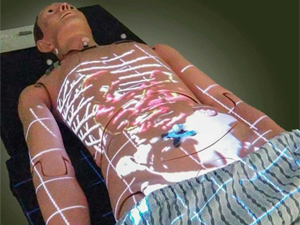



Date:26/01/18
 Imagine if doctors could see through a patient's skin, and their perspective of the underlying bones and organs changed accordingly as the person moved around. Well, that's what scientists at the University of Alberta have developed – kind of. It's still in the experimental phase, and is known as ProjectDR.
Imagine if doctors could see through a patient's skin, and their perspective of the underlying bones and organs changed accordingly as the person moved around. Well, that's what scientists at the University of Alberta have developed – kind of. It's still in the experimental phase, and is known as ProjectDR.
The technology doesn't actually make the skin transparent, nor does it provide real-time images of the insides of the patient. Instead, it projects previously-obtained three-dimensional CT or MRI images onto the skin, so that they line up with the corresponding parts of the patient.
The system incorporates a projector, infrared cameras, and markers that are placed in strategic locations on the patient's body. The cameras track those markers, allowing the system to know the orientation of the body, so that the images projected onto the skin can move as the patient does.
It's also possible for the system to project segmented images, such as only the lungs or only the blood vessels, depending on what the situation calls for.
"There are lots of applications for this technology, including in teaching, physiotherapy, laparoscopic surgery and even surgical planning," says Ian Watts, a computing science graduate student who created the system along with grad student Michael Fiest.
ProjectDR is demonstrated in the video below.
ProjectDR allows doctors to “see into” patients’ bodies
 Imagine if doctors could see through a patient's skin, and their perspective of the underlying bones and organs changed accordingly as the person moved around. Well, that's what scientists at the University of Alberta have developed – kind of. It's still in the experimental phase, and is known as ProjectDR.
Imagine if doctors could see through a patient's skin, and their perspective of the underlying bones and organs changed accordingly as the person moved around. Well, that's what scientists at the University of Alberta have developed – kind of. It's still in the experimental phase, and is known as ProjectDR.The technology doesn't actually make the skin transparent, nor does it provide real-time images of the insides of the patient. Instead, it projects previously-obtained three-dimensional CT or MRI images onto the skin, so that they line up with the corresponding parts of the patient.
The system incorporates a projector, infrared cameras, and markers that are placed in strategic locations on the patient's body. The cameras track those markers, allowing the system to know the orientation of the body, so that the images projected onto the skin can move as the patient does.
It's also possible for the system to project segmented images, such as only the lungs or only the blood vessels, depending on what the situation calls for.
"There are lots of applications for this technology, including in teaching, physiotherapy, laparoscopic surgery and even surgical planning," says Ian Watts, a computing science graduate student who created the system along with grad student Michael Fiest.
ProjectDR is demonstrated in the video below.
Views: 354
©ictnews.az. All rights reserved.Similar news
- Azerbaijani project to monitor disease via mobile phones
- Innovative educational system to be improved under presidential decree
- NTRC prolongs license of two TV and radio organizations for 6 years
- Azerbaijan establishes e-registry for medicines
- Azerbaijani museum introduces e-guide
- Nar Mobile opens “Nar Dunyasi” sales and service center in Siyazan city
- International conference on custom electronic services held in Baku
- OIC secretary general to attend COMSTECH meeting in Baku
- Azerbaijan develops earthquake warning system
- New law to regulate transition to digital broadcasting in Azerbaijan
- Azerbaijani State Social Protection Fund introduces electronic digital signature
- Intellectual traffic management system in Baku to be commissioned in December
- Tax Ministry of Azerbaijan started receiving video-addresses
- World Bank recommends Azerbaijan to speed up e-service introduction in real estate
- Azerbaijan to shift to electronic registration of real estate





















